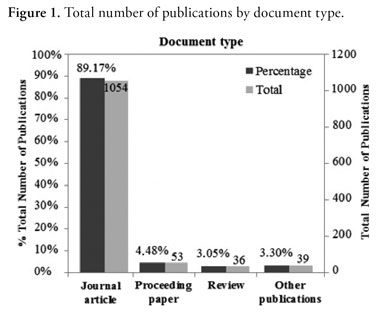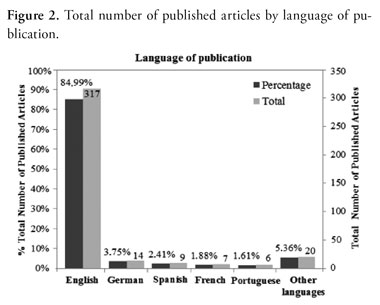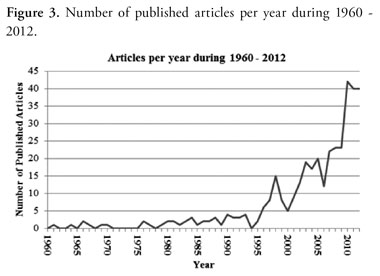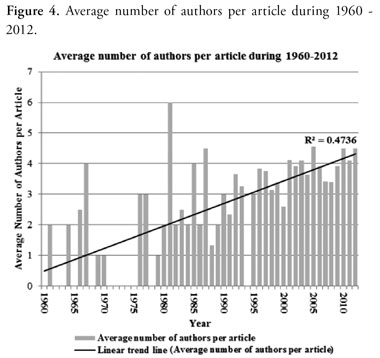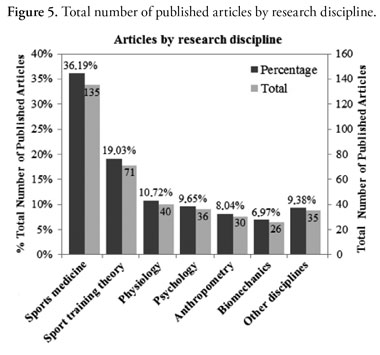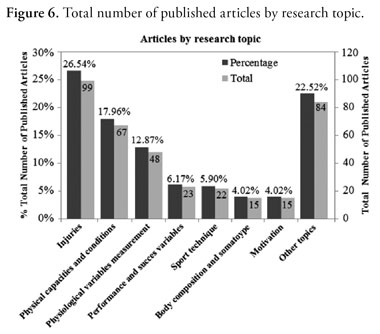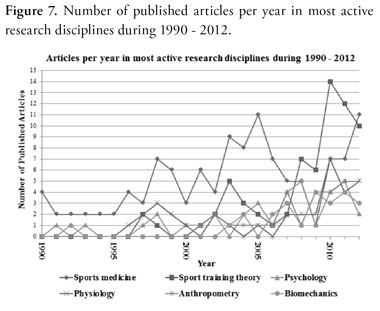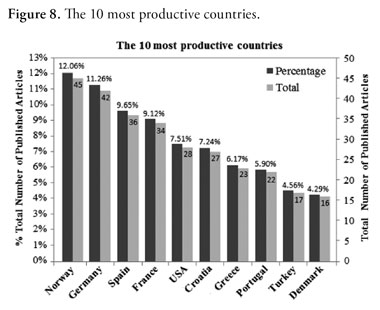My SciELO
Services on Demand
Journal
Article
Indicators
-
 Cited by SciELO
Cited by SciELO -
 Access statistics
Access statistics
Related links
-
 Cited by Google
Cited by Google -
 Similars in
SciELO
Similars in
SciELO -
 Similars in Google
Similars in Google
Share
Cuadernos de Psicología del Deporte
On-line version ISSN 1989-5879Print version ISSN 1578-8423
CPD vol.15 n.3 Murcia Sep. 2015
https://dx.doi.org/10.4321/S1578-84232015000300014
A bibliometric review of the scientific production in handball
Revisión bibliométrica de la producción científica en balonmano
Revisão bibliométrica da produção científica no handebol
Jaime Prieto1, Miguel-Ángel Gómez1 and Jaime Sampaio2
1 Faculty of Sciences for Physical Activity and Sport (INEF), Polytechnic University of Madrid, Spain
2 Research Center in Sport Sciences, Health and Human Development, University of Trás-os-Montes e Alto Douro at Vila Real, Portugal
ABSTRACT
The aim of the present study was to provide a bibliometric review of the scientific production in handball. Publications were collected from the Web of Science and MEDLINE databases for the period 1900-2012 and 1950-2012 respectively. The analysis assessed the document types and languages, annual trend of published articles, average number of authors per article, research disciplines and topics, trend of publication in research disciplines, major journals, author productivity, and country distribution of publications. Only the papers focused mainly on handball were considered, for a total of 373 articles under study. There was a significant increase in number of published articles and average number of authors per article in recent years, which allows considering handball an expanding research field both in terms of scientific production and research collaboration. Sports medicine was the most active research discipline, the studies focused on injuries the main topic. In the last two decades there was a remarkable annual growth in the disciplines of sport training theory, anthropometry and biomechanics. European authors participated in 87.94% of the articles, Norwegians the most active, revealing Europe's big dominance in handball research. This study provides baseline information on future research directions for researchers and academic institutions interested in handball.
Key words: Bibliometrics, research evaluation, scientometrics, team sports.
RESUMEN
El propósito de este estudio fue realizar una revisión bibliométrica de la producción científica en balonmano. Las publicaciones se recopilaron de las bases de datos Web of Science y MEDLINE en el periodo 1900-2012 y 1950-2012 respectivamente. El análisis evaluó el tipo de documento, idioma, tendencia anual de publicación, número medio de autores por artículo, disciplinas y temas de investigación, tendencias de publicación en las disciplinas de investigación, principales revistas, productividad de autores y distribución por países. Solo los artículos centrados principalmente en balonmano fueron considerados, para un total de 373 artículos. En los últimos años se observó un incremento significativo en el número de artículos publicados y en el número medio de autores por artículo, lo que permite considerar al balonmano como un área de investigación en expansión, tanto en términos de producción científica como en colaboración entre investigadores. La medicina deportiva fue la disciplina con más publicaciones, siendo los estudios de lesiones el tema principal. En las últimas dos décadas se observó un destacable crecimiento anual en las disciplinas de teoría del entrenamiento deportivo, antropometría y biomecánica. En el 87,94% de los artículos participaron autores europeos, siendo los noruegos los más prolíficos, lo que revela el dominio de Europa en la investigación en balonmano. Este estudio aporta información sobre potenciales líneas de investigación para el futuro, tanto para investigadores como para instituciones académicas interesadas en el balonmano.
Palabras clave: Bibliometría, evaluación de la investigación, cienciometría, deportes de equipo.
RESUMO
O objetivo deste estudo foi realizar uma revisão bibliográfica da produção científica no handebol. As publicações foram coletados a partir de bases de dados Web of Science e MEDLINE no período de 1900-2012 e 1950-2012, respectivamente. A análise avaliou o tipo de documento, idioma, viés de publicação anual, número médio de autores por artigo, disciplinas e temas de investigação, tendências de publicação no disciplinas de investigação, principais revistas, produtividade de autores e alocação país. Nos últimos anos, observou-se um aumento significativo no número de artigos publicados e o número médio de autores por artigo, permitindo considerar handebol como uma expansão na área de pesquisa, tanto em termos de produção científica e colaboração entre pesquisadores. Medicina do esporte é a disciplina com mais artigos, sendo o assunto principal estuda lesões. Nas duas últimas décadas observou-se um crescimento anual notável nas disciplinas de formação desportiva teoria, antropometria e biomecânica. Em 87,94% dos artigos envolvidos autores europeus, sendo o mais prolífico da Noruega, indicando o predomínio da Europa em investigação no handebol. Este estudo fornece informações básicas sobre os rumos da pesquisa em potencial para o futuro, tanto para pesquisadores e instituições acadêmicas interessadas em andebol.
Palavras-chave: Bibliometria, avaliação da investigação, cienciometria, esportes de equipe.
Introduction
Bibliometric studies have become a useful tool to evaluate the scientific production of research institutions and countries in an international context, and to identify developing or regressing areas of research. The results of such studies can be used as indicators of scientific productivity, trends, emphasis of research in various disciplines, and of researchers' preferences for publication outputs (Jacobs, 2001). A bibliometric study can be based on any sufficiently large publication list compiled and issued. The vast specialized or multidisciplinary databases are the most reliable sources for conducting rigorous bibliometric analyses (e.g. Academic Search, ProQuest, Scopus, Science Direct). In particular, the databases of the Institute for Scientific Information (ISI), now Thomson Reuters ISI (Philadelphia, PA, USA), have become the most generally accepted basic source for bibliometric studies (Glänzel, 2005). Thomson Reuters ISI contains databases covering thousands of academic journals in six major subject areas: Chemistry; Physics, Engineering & Mathematics; Medicine; Life Sciences; Social Sciences; and Arts & Humanities (McVeigh, 2004). All of these are available online via Thomson Reuters ISI Web of Knowledge database service.
Handball is one of the most popular team sports (Clanton & Dwight, 1997). It is played in 183 countries, especially in the European area, there are 19 million players and 795,000 teams worldwide (International Handball Federation, 2009). This great popularization of handball has been in line with an apparent significant increase in the number of related scientific publications. However, the non-existence of any published bibliometric study regarding scientific production in handball makes it difficult to prove this point. Applied to a particular scientific field, bibliometric analysis of publication activity provides a useful tool for evaluating the temporal evolution and nature of the research on a specific topic and for tracing the emergence of new disciplines, and thus increasing knowledge (Russell & Rousseau, 2002). In the field of sports science, several studies have evaluated bibliometric production and research projects (e.g., Olmedilla, Ortega, González, & Hernán-Villarejo, 2013; Ortega, Valdivia-Moral, Hernán-Villarejo, & Olmedilla, 2014; Sáenz et al., 2015; Villarejo, Palao, & Ortega, 2010). Therefore, performing a bibliometric study on handball may provide researchers with useful indicators about trends of publication, and baseline information for identifying the most active research disciplines, as well as the topics of greatest interest and future potential research directions. Furthermore, the study might provide useful information about the major journals chosen by researchers in the field to publish, and the most prolific authors and countries.
Within this context, the aim of the present study was to provide a bibliometric review of the scientific production in handball. The main objectives of the study are: (1) to characterize the publications by document type and language; (2) to show the annual trend of published articles and the average number of authors per article; (3) to identify the most active research disciplines and topics; (4) to present the recent trend of publication in the most active research disciplines; and (5) to identify the most active journals, authors and countries in handball research.
Material and methods
Data source
Data was collected from the Thomson Reuters ISI Web of Knowledge database service, selecting the databases of the Web of Science (which offers access to six comprehensive citation databases: Science Citation Index Expanded, Social Sciences Citation Index, Arts & Humanities Citation Index, Conference Proceedings Citation Index, Index Chemicus and Current Chemical Reactions) and the U.S. National Library of Medicine premier life sciences database MEDLINE. The study was conducted for the period 1900-2012. The Web of Science provides backfiles available to 1900. MEDLINE provides backfiles to 1950.
Search strategy
All the records that contained the word "handball" in the title, abstract, author keywords, or keywords plus (i.e., index terms created by Thomson Reuters in which the terms are derived from the titles of articles cited by the author of the article being indexed, which augments traditional key word or title retrieval) were compiled for analysis into a single database, using the web-based reference management software package RefWorks (ProQuest LLC, MD, USA). A total of 1,286 records were downloaded: 841 from the Web of Science, and 445 from MEDLINE. Duplicated records (104) were removed, for a total of 1,182 publications under study.
Bibliometric analysis
The subsequent bibliometric analysis considered the following variables: document types and languages, annual trend of published articles, average number of authors per article, research disciplines and topics, trends of publication in the most active research disciplines, major journals, author productivity, and country distribution of publications.
Document type
In a first step, the type of document of all the 1,182 publications was analyzed. It was considered the document type categorization offered by the Web of Science and MEDLINE databases (i.e., journal article, proceeding paper, review, case report, meeting abstract, book chapter, editorial material, etc.). Following the methodology established in other bibliometric studies, further analysis was restricted to journal articles (Börner, Chen, & Boyack, 2003; Liu, Zhan, Hong, Niu, & Liu, 2012). Articles as products of research are published in academic journals only after undergoing a peer review process (usually anonymous) by experts in the field. Thus, their contributions have been previously evaluated according to internationally agreed standards of experimental method, reproducibility and significance (Darch & Underwood, 2005). From among the 1,182 publications compiled, 1,054 were journal articles.
Next, each of the 1,054 journal articles was analyzed separately, selecting for investigation only the papers focused mainly on handball, with a specific interest recognizable after reading the title and the abstract. Articles that may have some application in handball, but focused on other topics were not considered. In doubtful cases, the full text of the article was read. After this process, 373 articles were considered as papers focused mainly on handball. All the further analysis was restricted to these 373 articles.
Language of publication
The language of publication of each article was extracted from the records downloaded from the Web of Science and MEDLINE databases. In this respect, it is important to highlight that the language of publication of research articles do not always coincide with the language of publication of the journals in which they are published. In fact, there are journals that publish articles in more than one language.
Annual trend of published articles
In order to analyze the evolution in the annual trend of publication in handball studies, and, therefore, establish whether handball is, or not, a research area with a growing scientific interest, the total number of published articles per year was calculated.
Average number of authors per article
In order to analyze the evolution in the degree of collaboration between authors in handball research, the average number of authors per article was calculated for each year (i.e., the total number of published articles in a year, divided by the total number of authors signing in all those articles).
Research disciplines and topics
The 373 studied articles were distributed among the 22 research disciplines identified by Devís-Devís, Valenciano, Villamón, and Pérez-Samaniego (2010) in the field of physical activity and sport science (i.e., sports medicine, physiology, psychology, biomechanics, sport training theory, anthropometry, psychomotricity, sociology, kinesiology, nutrition, etc.). This distribution was conducted through visual inspection, after reading the title and the abstract of each paper. In doubtful cases, the full text of the article was read. After, a more detailed study of the specific research topic of each article was conducted, following also the categorization of the 42 main research topics in the field of physical activity and sport science given by Devís-Devís et al. (2010) (i.e., injuries, physical capacities and conditions, sport technique, physiological variables measurement, psychological interventions, performance and success variables, diet and nutrition intakes, etc.). As with the research disciplines, each article was distributed into a specific research topic after reading the title and the abstract. Likewise, in doubtful cases, the full text of the article was read. To our knowledge, the categorization given by Devís-Devís et al. (2010) is the only existing that establishes which are the different research disciplines and topics in the field of physical activity and sport science.
Trend of publication in the most active research disciplines
In order to identify developing or regressing research disciplines, the number of published articles per year in the last two decades (1990-2012) in the most active research disciplines was calculated.
Major journals
In order to identify the most productive journals, the total number of Published Articles (PA) by each journal was considered. Next, the number of citations received by each of the articles published by each of the journals was summed, obtaining a Total Citation Count (TCC) that determines the most cited journals in handball research. Moreover, the Average Number of Citations (ANC) received by the journals for each of the articles focused on handball they have published was calculated (i.e., ANC=TCC/PA). This ANC may constitute a useful indicator for researchers to find out which are the top considered journals in handball research. The number of citations received by each article was extracted from the ISI Web of Knowledge database service, which counts the times an article is cited in the ISI Web of Knowledge indexed publications. Finally, the Impact Factor (IF) of each journal was gathered, according to the Journal Citation Reports (JCR) values in 2011. The annual JCR IF of a journal is calculated by dividing the number of current year citations to the source items published in that journal during the previous two years. JCR IF is considered to be a critical journal performance metric, as it reflects the citation activity for journal articles, allowing the journals to be ranked among journals of similar subject (Mc Veigh, 2004).
Author productivity
In order to identify the most prolific authors in handball research, all the authors that contributed to the 373 articles under study were recorded. Next, the total number of Published Articles (PA) in which each author signed was counted. Moreover, in order to distinguish between leading authors and collaborating authors, the number of articles in which an author signed as first author (if any), and the number of articles in which they signed as collaborating author (if any) was evaluated and counted. The first author's name identified the leading author of each article, as usual in social science research publications, particularly in the field of sport science and medicine. The rest of authors writing an article (if any) were considered collaborating authors.
Country distribution of publications
As with other bibliometric studies (Ugolini et al., 2012), the first author's country identified the country of origin of each article. Publications conducted in England, Northern Ireland, Scotland, and Wales were grouped into publications from the United Kingdom (UK), as usual in worldwide bibliometric studies.
Results
Document type
The document type of all the publications under study is presented in Figure 1. Peer-reviewed journal articles (n=1,054) were the leading type of publication, representing 89.17% of the references under analysis, followed far behind by proceeding papers (n=53; 4.48%), reviews (n=36; 3.05%), meeting abstracts (n=24; 2.03%), editorial material (n=4; 0.34%), notes (n=3; 0,25%), correction (n=2; 0.17%), letter (n=2; 0.17%), news item (n=2; 0.17%), book chapter (n=1; 0.08%), and book review (n=1; 0.08%).
Language of publication
With respect to the language of publication (Figure 2), 84.99% of the 373 studied articles were written in English (n=317), high above the other publication languages, which were German (n=14 articles; 3.75% out of the total), Spanish (n=9; 2.41%), French (n=7; 1.88%), Portuguese (n=6; 1.61%), Japanese (n=4; 1.07%), Italian (n=2; 0.54%), Croatian (n=2; 0.54%), Czech (n=2; 0.54%), Danish (n=2; 0.54%), Norwegian (n=2; 0.54%), Swedish (n=2; 0.54%), Chinese (n=1; 0,27%), Polish (n=1; 0.27%), Romanian (n=1; 0.27%), and Serbian (1; 0.27%).
Annual trend of published articles
The annual trend of published articles is presented in Figure 3. The first article published in handball research was Hemodynamic characteristics of athletes who play competitive handball and volley-ball (Georgescu & Dobreanu-Enescu, 1961). From this year to 1995 the number of published articles remained in very low figures, with less than 5 articles per year, and several years with no published articles. It is remarkable the 4-year period between 1971 and 1975 in which nothing was published. Since 1996 there was a gradual increase in the number of articles, with some years in which the production declined (1999, 2000, 2004 and 2006), but a clear ascending global trend, increasing from 6 articles published in 1996 to 40 articles in 2012. This trend of publication shows a solid development in handball research, especially since 2010, as the number of published articles almost doubled those from previous years (from 22, 23 and 23 articles in 2007, 2008 and 2009, to 42, 40 and 40 in 2010, 2011 and 2012 respectively).
Average number of authors per article
The average number of authors per article, along with the linear trend line which best adjusted to these data is presented in Figure 4. There was an important increase in the average number of authors contributing to articles, from 2.63 authors per article in the period 1961-1995 to 3.81 in the period 1996-2012. The R-squared value of the linear trend line was 0.4736. This Figure was significantly affected by those years in which no articles were published. In any case, this shows a major degree of collaboration in handball studies over time, especially in recent years.
Research disciplines
The distribution of the articles in the most productive research disciplines is presented in Figure 5. The six disciplines with the greatest volume of published articles were sports medicine (n=135 articles; 36.19% of the total), sport training theory (n=71; 19.03%), physiology (n=40; 10.72%), psychology (n=36; 9.65%), anthropometry (n=30; 8.04%), and biomechanics (n=26; 6.97%). These top-6 research disciplines accounted for 90.62% of the studied articles. The 9.38% of remaining articles were distributed among the following disciplines: physical education and sport theory (n=9; 2.41%), engineering (n=6; 1.61%), sociology (n=6; 1.61%), nutrition (n=5; 1.34%), kinesiology (n=4; 1.07%), psychomotricity (n=4; 1.07%), and history (n=1; 0.27%).
Research topics
The distribution of the articles in the most productive research topics is presented in Figure 6. The main research topic was injuries, with 99 published articles (26.54% of the total), followed by physical capacities and conditions (n=67 articles; 17.96% of the total), physiological variables measurement (n=48; 12.87%), performance and success variables (n=23; 6.17%), sport technique (n=22; 5.90%), body composition and somatotype (n=15; 4.02%), and motivation (n=15; 4.02%). These top-7 research topics accounted for 77.48% of the articles. The 22.52% of remaining articles were mainly distributed among the following research topics: psychological interventions (n=12; 3.22%), physiological responses and adaptations to exercise (n=9; 2.41%), visual capacity in sport (n=8; 2.14%), media training (n=7; 1.88%), and physical-sport culture (n=6; 1.61%).
Trend of publication in the most active research disciplines
The annual evolution in the number of published articles since 1990 in the most active research disciplines is presented in Figure 7. Articles published in the discipline of sports medicine occupy the first position in almost every year of this period, a trend that continues. There was a significant increase in the category of sport training theory since 2008, being the discipline with the higher number of published articles in 2008, 2009, 2010, and 2011. Likewise, in recent years, there was a remarkable annual growth in the publication of articles in the disciplines of anthropometry and biomechanics, which had very few publications until the beginning of the 2000s.
Major journals
A total of 140 journals published the 373 articles under analysis. The 10 most active journals in handball research are presented in Table 1, along with the number of articles, the number of citations received, the average of citations in a paper, and the impact factor of the journal. A total of 135 articles were published in this top-10 most active journals (7.14% out of the 140 journals), amassing 36.19% of the published articles. With more than 5% of the total published articles the Scandinavian Journal of Medicine & Science in Sports (24 articles; 6.43%) and the Journal of Strength and Conditioning Research (20 articles; 5.36%) stand out, followed by Perceptual and Motor Skills with 15 articles (4.02%). As for the number of citations received, these top-10 journals received 1,849 or 55.39% of the total of 3,338 citations received by all the retrieved articles. Likewise, it is remarkable that two of these journals (i.e., Scandinavian Journal of Medicine & Science in Sports, and American Journal of Sports Medicine) account for 34.42% of the total citations. In this respect, is surprising the case of the Clinical Journal of Sport Medicine, that with only 5 published articles (1.34% out of the total publications), received 311 citations (9.32% out of the total citations), for an average of 62.20 citations per article. This is mainly because of the 228 citations received by the article: Prevention of anterior cruciate ligament injuries in female team handball players: A prospective intervention study over three seasons (Myklebust, et al., 2003), which therefore is considered a significant contribution. Other featured articles which were cited more than 100 times were: Injury mechanisms for anterior cruciate ligament injuries in team handball: a systematic video analysis (Olsen, Myklebust, Engebretsen, & Bahr, 2004); A prospective cohort study of anterior cruciate ligament injuries in elite Norwegian team handball (Myklebust, Maehlum, Holm, & Bahr, 1998); Motivation and dropout in female handballers: a 21-month prospective study (Sarrazin, Vallerand, Guillet, Pelletier, & Cury, 2002); and Prevention of injuries in young female players in European team handball: a prospective intervention study (Wedderkopp, Kaltoft, Lundgaard, Rosendahl, & Froberg, 1999), with 236, 171, 119, and 117 citations respectively.
Author productivity
A total of 782 different authors signed in the 373 retrieved articles. The 10 most productive authors in handball research in leading author publications and collaborating publications, along with their country of origin, are presented in Table 2. These top-10 most productive authors (1.28% out of the total authors) signed in 106 articles (28.42% out of the total articles). This is consistent with observations in most research fields, where a few prolific authors contribute to a significant share of publications. The most prolific authors in handball research, with 10 or more published articles, were: van den Tillar, R. (Norway) with 17 articles (being leading author in 13 of them), Myklebust, G. (Norway) with 14 articles (4 leading authorships), Engebretsen, L. (Norway) with 12 articles (non-leading author), Bahr, R. (Norway) with 11 articles (non-leading author), Bar-Sela, S. (Israel) with 11articles (non-leading author), and Ettema, G. (Norway) with 10 articles (1 leading authorship). Five of these six most productive authors were Norwegians, revealing the importance of handball research in this country. An in-depth analysis of country contribution to handball publications is presented in the following section. It also highlights the cases of Schorer, J. (Germany), Filaire, E. (France), and Wagner, H. (Austria), who despite signing in fewer articles, had 8, 7, and 6 leading authorship publications respectively.
Country distribution of publications
A total of 31 countries contributed to the publication of the 373 studied articles. The 10 most productive countries are presented in Figure 8. Out of these top-10 most productive countries, 9 countries were Europeans, only with the USA (North America) occupying the fifth position. Out of the total countries, European countries participated in 87.94% of the articles, revealing Europe's big domain in handball research.
Discussion
In a period when bibliometric indicators are increasingly being employed in the assessment of individual, institutional, and national performance (Ugolini et al., 2012), handball, as a multidisciplinary research area with a rising scientific interest, merited a thorough review. The purpose of the present study was to provide a bibliometric review of the scientific production in handball. Publications were collected from the Web of Science and MEDLINE databases for the period 1900-2012 and 1950-2012 respectively.
The most frequent document type was peer-reviewed journal articles (n=1,054), which accounted for 89.17% of the total publications. This shows that when having to present their latest and most important findings, researchers in the field of handball choose articles of scientific journals as the main dissemination medium. This is consistent with the majority of scientific research fields, in which scientific articles published in academic journals continue to be the main vehicle to present the latest and most important advances made by researchers. Only the papers focused mainly on handball were considered for further analysis, for a total of 373 articles under study, 317 of which (84.99%) were written in English. This reaffirms the fact that English is the predominant academic language and that most scientific journals indexed in international academic databases are published in English (Patra, Bhattacharya, & Verma, 2006).
From 1961, when the first scientific article in handball was published, to 1995, the number of published articles remained at levels below 5 publications per year. Since 1996 there has been a gradual increase in the number of articles, especially since 2010, as the number of published articles in previous years has almost doubled to reach approximate numbers of 40 articles per year. This shows an important development in handball research in recent years. At the same time there was a parallel increase in the average number of authors per article. This shows a major degree of collaboration in handball studies, which is consistent with the authoring patterns in other research areas (Shrum, Genuth, & Chompalov, 2007), particularly in sport sciences (Valenciano, Devís-Devís, Villamón, & Peiró-Velert, 2010). Therefore, handball can be considered an expanding research field both in terms of growing scientific production and research collaboration.
Sports medicine was the discipline with the most published articles, followed by sport training theory, physiology, psychology, anthropometry, and biomechanics. These top-6 disciplines accounted for 90.62% of the studied articles. It highlights the fact that five of the top-6 disciplines were related to a greater or lesser extent with the medical sciences (i.e., sports medicine, physiology, psychology, anthropometry, and biomechanics), revealing that handball is a sport with a high physical, physiological and psychological component wherein studies related to injuries, physical capacities, physiological components, etc. are common (Ziv & Lidor, 2009, Myklebust, Hasslan, Bahr, & Steffen, 2013). Injuries was the main research topic, which is consistent with the great incidence of injuries in handball. Handball is categorized as a contact sport where physical contact and aggressiveness is present in the game (Prieto & Gómez, 2012). These characteristics make handball a sport with a great incidence of injuries (Lindblad, Jensen, Terkelsen, & Helleland, 1993; Tsigilis & Hatzimanouil, 2005), which increases with performance level (Langevoort, Myklebust, Dvorak, & Junge, 2007). The following most common research topics were physical capacities and conditions, physiological variables measurement, performance and success variables, and sport technique.
In the last two decades (1990-2012), articles published in the discipline of sports medicine continue to be the main trend in handball research publication, occupying the first position in almost every year of this period. In this same period there was a significant increase in the category of sport training theory since 2008, becoming the discipline with more published articles in 2008, 2009, 2010, and 2011. This is consistent with the growing interest of this research discipline in other team sports in recent years, which includes emerging research topics regarding the performance analysis, such as game sports modeling (Lames, 2006), decision-making behaviours (Passos et al., 2008), complex behavioural dynamics (Duarte et al., 2010), ecological dynamics (Vilar, Araújo, Davids, & Button, 2012), contextual constraints (Correia et al., 2012), etc. This underlines the growing trend to consider sports contests as complex dynamical systems (Reed & Hughes, 2006; Lames & McGarry, 2007; Bourbousson, Sève, & Mcgarry, 2010). Therefore, analyzing the game of handball as a complex dynamical system is a potentially interesting line for future research. Likewise, in recent years, there was a remarkable annual growth in the publication of articles in the disciplines of anthropometry and biomechanics, which had very few publications until the beginning of the 2000s. This suggests that studies referring to these two disciplines will be expected to have a continuous rising trend in the years to come.
Scandinavian Journal of Medicine & Science in Sports, Journal of Strength and Conditioning Research, and Perceptual and Motor Skills were the most active journals in handball research. The authorship pattern revealed a small group of authors signing in an important number of publications. In particular, five of the top-6 most productive authors were Norwegians, revealing the importance of handball in this country, which is consistent with the importance of handball as sport in Norway (Førde, 2002). According to the territory, European countries participated in 87.94% of the articles, revealing Europe's big domain in handball research. This is consistent with the great popularization of handball in Europe as sport and its domain in international handball competitions, both male and female.
A number of limitations affecting the study need to be addressed. Bibliometric analysis depends on the selected bibliographic materials, therefore the present findings and associated interpretations only aim at evaluating handball research progress based on the selected Thomson Reuter ISI databases (Web of Science and MEDLINE). Moreover, regarding the distribution of the articles among the different research disciplines and topics, this was conditioned by the only existing categorization (Devís-Devís et al., 2010). In addition, the attribution of each article to a single country based on the first author country of origin may be misleading, although in previous bibliometric studies it was demonstrated that different methods give similar results (Ugolini et al., 2012). However, since the objective of this research was to provide an exploratory bibliometric study, we believe it constitutes a fair representation of the general situation in handball research.
Practical implications
This work shows the important development in handball research in recent years, which is increasingly fruit of the collaboration of researchers from different countries working together, mainly from Europe. Academic institutions, universities, journals, researchers, professionals, teachers and students can benefit from the presented insights into handball international scientific production. Knowing which disciplines are the most and least researched can help sports academic institutions to manage in a better way their resources and teaching programs concerning handball. Researchers may find very helpful the information about research disciplines and topics in order to find new opportunities and challenges in handball research. Additionally, they can consult the most active journals when deciding to which journal submit their handball scientific contributions. Journals can consult the most prolific authors when having to contact potential reviewers for papers on handball. Moreover, this paper might be useful to conduct informed decisions on researcher's curriculum development and for sports universities journal subscription.
The study should also encourage researchers to continue working in the area of sports medicine, concretely in the injuries associated to handball, as it remains the main topic of interest. Furthermore, the growing interest of sport training theory, and the growing trend to consider sports contests as complex dynamical systems, together with the lack of research in handball, makes it a potential area for future work. A suggestion for future study would be to analyze the degree to which the observed rates of publication, trends in research disciplines and topics, as well as most productive journals, authors, and countries, progresses as expected. Other directions could include the evaluation and comparison of handball research performance across universities, sports laboratories and specific research groups. Additionally, the organization of handball research using the new promising bibliometric science mapping techniques may contribute in shaping future research perspectives, for example, when considering the relationships between papers keywords and research disciplines.
Acknowledgements
We gratefully acknowledge Pablo González and Kate McFadden for the final English style correction of the manuscript. None of the authors has any conflict of interest.
References
1. Bourbousson, J., Sève, C., & Mcgarry, T. (2010). Space-time coordination dynamics in basketball: part 1. Intra- and inter-couplings among player dyads. Journal of Sports Sciences, 28(3), 339-347. [ Links ]
2. Börner, K., Chen, C., & Boyack, K. (2003). Visualizing knowledge domains. In B. Cronin (Ed.), Annual review of information science and technology (pp. 179-255). Medford, NJ: Information Today. [ Links ]
3. Clanton, R. E., & Dwight, M. P. (1997). Team handball: Steps to Success. Champaign, IL: Human Kinetics. [ Links ]
4. Correia, V., Araújo, D., Duarte, R., Travassos, B., Passos, P., & Davids, K. (2012). Changes in practice task constraints shape decision-making behaviours of team games players. Journal of Science and Medicine in Sport, 15, 244-249. [ Links ]
5. Darch, C., & Underwood, P. (2005). Are pre-compiled citation indexes of peer-reviewed journals an adequate control for research quality? A case study of library and information science. South Africa Journal of Libraries and Information Science, 71(1), 1-10. [ Links ]
6. Devís-Devís, J., Valenciano, J., Villamón, M., & Pérez-Samaniego, V. (2010). Disciplines and themes of study in physical activity and sport science. Revista Internacional de Medicina y Ciencias de la Actividad Física y el Deporte, 10(37), 150-166. [ Links ]
7. Duarte, R., Araújo, D., Fernandes, O., Fonseca, C., Correia, V., Gazimba, V., et al. (2010). Capturing complex human behaviors in representative sports contexts with a single camera. Medicina (Kaunas), 46(6), 408-414. [ Links ]
8. Førde, O. (2002). Sports in Norway. In Norway: Country Study Guide. USA: International Business Publications. [ Links ]
9. Georgescu, M., & Dobreanu-Enescu, V. (1961). Hemodynamic characteristics of athletes who play competitive handball and volley-ball. Studii si cercetari de medicina interna, 2, 91-98. [ Links ]
10. Glänzel, W. (2003). Bibliometrics as a research field: A course on theory and application of bibliometric indicators. Retrieved July 20, 2013 from http://www.cin.ufpe.br/~ajhol/futuro/references/01%23_Bibliometrics_Module_KUL_BIBLIOMETRICS%20AS%20A%20RESEARCH%20FIELD.pdf. [ Links ]
11. Jacobs, D. (2001). A bibliometric study of the publication patterns of scientists in South Africa 1992-96, with particular reference to status and funding. Information Research, 6, 3. Retrieved July 16, 2013 from http://InformationR.net/6-2/paper104.html. [ Links ]
12. Lames, M. (2006). Modelling the interaction in game sports: Relative-phase and moving correlations. Journal of Sports Science and Medicine, 5, 556-560. [ Links ]
13. Lames, M., & McGarry, T. (2007). On the search for reliable performance indicators in game sports. International Journal of Performance Analysis in Sport, 7(1), 62-79. [ Links ]
14. Langevoort, G., Myklebust, G., Dvorak, J., & Junge, A. (2007). Handball injuries during major international tournaments. Scandinavian Journal of Medicine & Science in Sports, 17, 400-407. [ Links ]
15. Lindblad, B. E., Jensen, K. H., Terkelsen, C. J., & Helleland, H. E. (1993). Handball injuries. An epidemiologic and socioeconomic study. Ugeskr Laeger, 155(45), 3636-36368. [ Links ]
16. Liu, X., Zhan, F. B., Hong, S., Niu, B., & Liu, Y. (2012). A bibliometric study of earthquake research: 1900-2010. Scientometrics, 92(3), 747-765. [ Links ]
17. McVeigh, M. E. (2004). Open Access Journals in the ISI Citation Databases: Analysis of Impact Factors and Citation Patterns. A citation study from Thomson Scientific. Thomson Scientific. Retrieved July 10, 2013 from: http://science.thomsonreuters.com/m/pdfs/openaccesscitations2.pdf. [ Links ]
18. Myklebust, G., Engebretsen, L., Braekken, I. H., Skjolberg, A., Olsen, O. E., & Bahr, R. (2003). Prevention of anterior cruciate ligament injuries in female team handball players: A prospective intervention study over three seasons. Clinical Journal of Sport Medicine, 13(2), 71-78. [ Links ]
19. Myklebust, G., Hasslan, L., Bahr, R., & Steffen, K. (2013). High prevalence of shoulder pain among elite Norwegian female handball players. Scandinavian Journal of Medicine & Science in Sports, 23(3): 288-294. [ Links ]
20. Myklebust, G., Maehlum, S., Holm, I., & Bahr, R. (1998). A prospective cohort study of anterior cruciate ligament injuries in elite Norwegian team handball. Scandinavian Journal of Medicine & Science in Sports, 8(3), 149-153. [ Links ]
21. Olmedilla, A., Ortega, E., González, J., & Hernán-Villarejo, D. (2013). Análisis de los proyectos de investigación de financiación pública en Psicología del Deporte (Analysis of draft publicly funded research in Sport Psychology). Anales de Psicología, 29(3), 714-723. [ Links ]
22. Olsen, O. E., Myklebust, G., Engebretsen, L., & Bahr, R. (2004). Injury mechanisms for anterior cruciate ligament injuries in team handball: a systematic video analysis. American Journal of Sports Medicine, 32(4), 1002-1012. [ Links ]
23. Ortega, E., Valdivia-Moral, P., Hernán-Villarejo, D., & Olmedilla, A. (2014). Análisis de los proyectos de investigación concedidos por el Consejo Superior de Deportes (2006-2012), desde una perspectiva de género (Gender-based analysis of research projects approved for funding by the "Consejo Superior de Deportes" (2006-2012)). Revista de Psicología del Deporte, 23(1), 95-100. [ Links ]
24. Passos, P., Araújo, D., Davids, K., Gouveia, L., Milho, J., & Serpa, S. (2008). Information-governing dynamics of attacker-defender interactions in youth rugby union. Journal of Sports Sciences, 26, 1421-1429. [ Links ]
25. Patra, S. K., Bhattacharya, P., & Verma, N. (2006). Bibliometric study of literature on bibliometrics. DESIDOC Bulletin of Information Technology, 26(1), 27-32. [ Links ]
26. Prieto, J., & Gómez, M. A. (2012). A comparative analysis of the home advantage in handball and rugby as contact sports. E-Balonmano.com: Journal of Sports Science, 8(1), 17-24. [ Links ]
27. Reed, D., & Hughes, M. (2006). An exploration of team sport as a dynamical system. International Journal of Performance Analysis in Sport, 6, 114-125. [ Links ]
28. Russell, J., & Rousseau, R. (2002). Bibliometrics and institutional evaluation. In Arvantis (Ed.), Encyclopedia of Life Support Systems (EOLSS). Part 19.3 Science and Technology Policy (Arvantis, ed.). Oxford (UK): Eolls Publishers. [ Links ]
29. Sáenz, A., Gimeno, F., Gutiérrez, H., Lacambra, D., Arroyo del Bosque, R., & Marcén, C. (2015). Evaluación de la violencia y deportividad en el deporte: un análisis bibliométrico (Evaluation of violence and sportsmanship in sport: bibliometric analysis). Cuadernos de Psicología del Deporte, 15(1), 211-222. [ Links ]
30. Sarrazin, P., Vallerand, R., Guillet, E., Pelletier, L., & Cury, F. (2002). Motivation and dropout in female handballers: a 21-month prospective study. European Journal of Social Psychology, 32(3), 395-418. [ Links ]
31. Shrum, W., Genuth, J., & Chompalov, I. (2007). Structures of Scientific Collaborations, Cambridge, London, The MIT Press. [ Links ]
32. Tsigilis, N., & Hatzimanouil, D. (2005). Injuries in handball: Examination of the risk factors. European Journal of Sports Science, 5, 137-142. [ Links ]
33. Ugolini, D., Neri, M., Cesario, A., Bonassi, S., Milazzo, D., Bennati, L., Lapenna, L. M., & Pasqualetti, P. (2012). Scientific production in cancer rehabilitation grows higher: a bibliometric analysis. Support Care Cancer, 20, 1629-1638. [ Links ]
34. Valenciano, J., Devís-Devís, J., Villamón, M., & Peiró-Velert, C. (2010). Scientific cooperation in the field of Physical Activity and Sport Science in Spain. Revista Española de Documentación Científica, 33(1), 90-105. [ Links ]
35. Vilar, L., Araújo, D., Davids, K., & Button, C. (2012). The role of ecological dynamics in analysing performance in team sports. Sports Medicine, 42(1), 1-10. [ Links ]
36. Villarejo, D., Palao, J. M., & Ortega, E. (2010). La producción científica en rugby union entre 1998-2007 (Scientific production in Rugby union betwen 1998-2007). E-balonmano. com: Revista de Ciencias del Deporte, 6(3), 155-161. [ Links ]
37. Wedderkopp, N., Kaltoft, M., Lundgaard, B., Rosendahl, M., & Froberg, K. (1999). Prevention of injuries in young female players in European team handball: a prospective intervention study. Scandinavian Journal of Medicine & Science in Sports, 9(1), 41-47. [ Links ]
38. Ziv, G., & Lidor, R. (2009). Physical characteristics, physiological attributes, and on-court performances of handball players: A review. European Journal of Sport Science, 9(6), 375-386. [ Links ]
![]() Correspondence:
Correspondence:
Jaime Prieto
Faculty of Sciences for Physical Activity and Sport (INEF),
Polytechnic University of Madrid,
Martín Fierro, 7, 28040 Madrid (Spain).
E-mail: jaimeprietobermejo@gmail.com
Recibido: 14/02/2015
Aceptado: 22/05/2015













